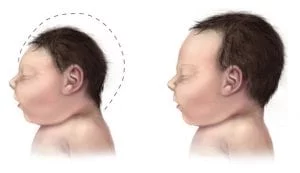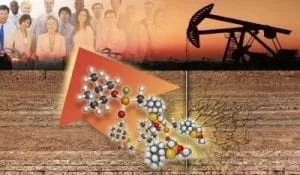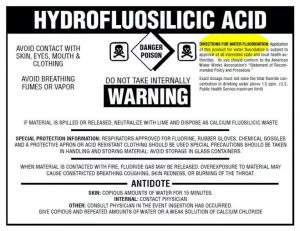Toxic Chemicals in Clothing
The clothing industry is actually one of the most polluting industries on the planet, and the textiles they produce may be laced with irritants and disease-causing chemicals, which is one of the reasons why it’s so important to wash new clothes before wearing them. Even then, however, it may not make the clothing entirely safe.
After clothes are made, they are often covered with formaldehyde to keep them from wrinkling or becoming mildewed during shipping. Several severe allergic reactions to formaldehyde have been reported, and investigations have discovered up to 900 times the recommended safe level of formaldehyde in clothing shipped to brand name clothiers from factories in China and Southeast Asia.
All synthetic materials are produced with toxic chemicals, and while they may not produce immediate reactions for most, the long term accumulation of these toxins added to our polluted air, water, and food can cause numerous health ailments, including cancer. Clothing that doesn’t require ironing or is labeled wrinkle free may even contain perfluorinated chemical (PFC) used to make Teflon – this chemical is known to cause health issues.
Another commonly used clothing or textile factory chemical is nonylphenol ethoxylate (NPE). Known as endocrine disruptors, like BPA, nonylphenos have been dumped into adjacent waterways, killing a lot of fish and wild life. This negative effect on sea wildlife is primarily why various concerned agencies in Europe and America restrict its use. But there are no restrictions where the clothing and textile factories are located in China and Southeast Asia.
Additionally, black clothing and dyes for leathers often contain p-Phenylenediamine (PPD), which can produce allergic reactions. Carcinogenic flame retardants can appear in bedding and nightwear. Lastly, volatile organic compounds (VOCs) and dioxin-producing bleach are used by textile industries, where the materials for clothing are produced. Dioxin is the active ingredient for Agent Orange.
In an interview with “clean-fashion pioneer” Marci Zaroff, Goop outlined some of the common chemicals likely to be found in your clothing:4
- Glyphosate, the most-used agricultural chemical, is an herbicide used to grow cotton. It’s linked to cancer and found in cotton textiles.
- Chlorine bleach, used for whitening and stain removal, may cause asthma and respiratory problems and is found in fiber/cotton processing, including in denim.
- Formaldehyde, which is carcinogenic, is used to create wrinkle-free clothing as well as for shrinkage and as a carrier for dyes and prints. It’s common in cotton and other natural fabrics, including anything that’s been dyed or printed.
- VOCs, solvents used for printing and other purposes, are common in finished textiles, especially those with prints. VOCs may off-gas from clothing, posing risks such as developmental and reproductive damage, liver problems and in some cases cancer, particularly to workers.
- PFCs, used widely in uniforms and outdoor clothing to create stain-repellant and water-resistant fabrics, are carcinogenic, build up in your body and are toxic to the environment.
- Brominated flame retardants, used to stop clothes from burning (although this is questionable), may be found in children’s clothing. These chemicals are neurotoxic endocrine disrupters that may also cause cancer.
- Ammonia, used to provide shrink resistance, is found in natural fabrics. It may be absorbed into your lungs and cause burning in your eyes, nose or throat.
- Heavy metals, including lead, cadmium, chromium and others, may be used for leather tanning and dyeing. They’re highly toxic and may be found in finished textiles, especially those that are dyed or printed.
- Phthalates/Plastisol, used in printing inks and other processes, are known endocrine disrupters.
You may assume that if you’re purchasing clothing in the U.S., it’s safe and free from toxins, but this isn’t typically the case. Zaroff told Goop:5
“The magnitude and multitude of toxic chemicals in the fashion and textile industries is out of control. Even though some carcinogens are regulated (for example, formaldehyde, linked to cancer, is regulated in the U.S.), most brands are still manufactured overseas, where regulation is far behind. And only the most toxic chemicals are regulated in the U.S., which means there are a huge number that are unregulated but likely to cause allergic reactions.”
This is an issue both for the people who wear the clothes as well as the environment. Textile dyeing facilities, for example, tend to be located in developing countries where regulations are lax and labor costs are low. Untreated or minimally treated wastewater is typically discharged into nearby rivers, from where it spreads into seas and oceans, traveling across the globe with the currents.
An estimated 40 percent of textile chemicals are discharged by China.6 According to Ecowatch, Indonesia is also struggling with the chemical fallout of the garment industry. The Citarum River is now one of the most heavily polluted rivers in the world, thanks to the congregation of hundreds of textile factories along its shorelines. Clothing designer Eileen Fisher even called the clothing industry the “second largest polluter in the world … second only to oil.”7
Genetically engineered (GE) cotton is widely used in the clothing industry, but while it maintains a natural image, it’s among the dirtiest crops in the world because of heavy use of toxic pesticides. It also takes a heavy toll on local water supplies, as hundreds of liters of water may be necessary to produce enough cotton to make one T-shirt.8
Prince Charles is among those who has voiced his support for more sustainable cotton production, noting that cotton production is “all too often associated with the depletion of local water supplies and the widespread, and sometimes indiscriminate, use of harmful pesticides [that] can take a heavy toll on human health.”9
Fortunately, earlier this year 13 clothing and textile companies, including Levi Strauss & Co., Eileen Fisher, Nike, Woolworths Holdings and Sainsbury’s, signed the Sustainable Cotton Communiqué, which commits to using 100 percent sustainable cotton by 2025. Worldwide, more than 20 million tons of cotton are produced annually in more than 100 countries.10 The 13 companies that signed the sustainable cotton initiative account for 300,000 tons of cotton each year.11
The “Care What You Wear” campaign’s purpose is to educate consumers about why and how to buy clothing that supports organic and regenerative farming, responsible production and fair labor practices — and to “expose today’s fast-fashion industry, which perpetuates ethically and environmentally unsound practices with its ‘buy more, cheaper clothes‘ message.” As for the “why,” consider these Care What You Wear facts:15
- It takes 5,000 gallons of water to manufacture one pair of jeans
- Cotton crops use 24 percent of all insecticides and 11 percent of all pesticides globally
- 25 percent of the chemicals produced in the world are used in textiles
Further, as noted by the campaign:
“Every time you buy a new article of clothing your purchase has a ripple effect on the environment. The global apparel industry is the second-largest industrial polluter.
From the growing of GMO cotton, to the production of wool and synthetic fibers, to the dyes used on those fibers, to the factories where clothes are assembled — each step of the way, soil is degraded, water is polluted, laborers are exploited. Can consumers help drive the fashion industry away from this toxic model, toward a more ethical, regenerative model? Yes, if we buy wisely.”16
Looking for clothing made from organic cotton is an excellent start to finding safe, nontoxic clothing (for you and the environment). Natural fiber clothing may also minimize the shedding of microfibers common to synthetic fibers.
You can also look for brands that have committed to chemical reduction (Target plans to remove PFCs and flame retardants from their products by 2022, for instance17) along with the Cradle to Cradle, GOTS-certified textiles or OEKO-TEX Standard 100 label, which is indicative that it has been tested by an independent laboratory and found to be free of harmful levels of more than 100 substances, including:
- Azo dyes
- Phthalates
- Heavy metals
- Pesticides
- Allergenic dye
Ultimately, the best choice for the environment is to purchase natural, organic, high-quality clothing and less clothing overall. You can also opt for vintage clothing or that found in thrift stores, as Zaroff explained:18
“In many ways, buying vintage is the best way to attack the problem of waste in fashion — the most sustainable piece is one that doesn’t have to be made in the first place. Additionally, most older clothes are much less toxic than what’s being produced today — chemical use in textile manufacturing wasn’t as ubiquitous until the last 50 years or so.
That said, germs and bacteria (including mold) can collect on old clothing, so stick to vintage that’s well-preserved, and clean it before you wear it, like everything else.”
Given the numerous toxins to avoid in daily life, there is no surprise that most people won’t stress about chemicals in clothing. But there are still some simple measures you can take to reduce toxic exposure.
- If you launder with common supermarket toxic detergents, switch to natural detergents. It will take a few washings to remove the residual toxic detergent ingredients completely.
- Read clothing labels and try to avoid synthetic materials such as Rayon, Nylon, Polyester, Acrylic, Acetate or Triacetate as much as possible. Also avoid no-iron, wrinkle free and preshrunk items. Basically, try to stay in the 100% pure cotton zone, or hemp clothing if you see any.
- Wash and dry clothes containing synthetic materials three times before wearing. Some folks add baking soda (not baking powder) to help neutralize new clothing chemicals while using natural detergents, of course. Also, avoid those dryer sheets that prevent clinging unless you can find them without toxic chemicals.
- Stay away from dry cleaners that use perchloroethylene, commonly known as PERC. There are actually some that don’t. Find them or forget dry cleaning. Even used clothing purchased from thrift stores may be sprayed with some chemical before they’re put up for sale. Wash and dry them at least once.
Sources: (NaturalSociety; Mercola)
Toxic Chemicals in the Air
According to a recent report by the Health Effects Institute,1 95 percent of the world live in areas where the pollution levels are higher than deemed safe by the World Health Organization (WHO). This makes air pollution the fourth largest cause of death, following high blood pressure, diet and smoking.
Fine particulate matter (PM) concentration exceeds 10 micrograms per meters cubed (ug/m3) for 95 percent of the world, and nearly 60 percent live in areas where the PM exceeds even the least stringent WHO air quality target of 35 ug/m3.2 Fine PM measuring less than 2.5 micrograms (PM2.5) is one indicator of outdoor pollution levels.
Experts estimate exposure to PM2.5 contributes to more than 6 million deaths worldwide and plays a large role in increasing the risk of stroke, lung cancer and heart attack. Although many developed countries have made significant moves toward reducing air pollution, developing countries have fallen further behind as they struggle for economic growth.3
Bob O’Keefe, vice president of the Health Effects Institute, believes there’s reason for optimism, though, as both China and India are taking steps to reduce pollution.4 Although the physical effects of air pollution are well-known, a recent study5 demonstrates it may cause a large reduction in intelligence, indicating damage of toxic air is far more significant than previously believed.
Air Pollution Damages Intelligence
Although data was collected on 20,000 people living in China, the researchers believe the findings are relevant to the entire world. They found6 language and arithmetic skills were affected, with the average impact on those tested equivalent to losing one year of education.
However, a member of the research team believes the effects may be even worse for the elderly and for those with a low education level. Calculating the loss in those individuals may increase damage to several years. The study authors concluded:7
“The damage on the aging brain by air pollution likely imposes substantial health and economic costs, considering that cognitive functioning is critical for the elderly for both running daily errands and making high-stake decisions.”
According to this study, the longer people were exposed, the greater the damage. Language skills were the most dramatically affected, in men more than women. Researchers monitored individuals for more than four years.8 Other studies have found air pollution harms cognitive performance in students. However, this is the first to examine individuals of all ages and the differences between men and women.
Data from other studies have linked air pollution to high mortality in those who suffer mental disorders.9 It’s also been found to raise the risk of mental illness in children,10 and those living near busy roads have an increased risk of dementia.11
According to researcher Derek Ho, Ph.D., from Hong Kong Polytechnic University, air pollution likely affects cognition because “high air pollution can potentially be associated with oxidative stress, neuroinflammation and neurodegeneration of humans.”12
Another member of the research team, Xi Chen at Yale School of Public Health, believes air pollution is most likely the cause of loss of intelligence rather than simply being correlated.
The team noted air pollution has a short-term impact on intelligence as well, which could have significant consequences for students who have to take crucial exams on polluted days. Dr. Aarash Saleh, from Doctors Against Diesel campaign, remarked:13
“This study adds to the concerning bank of evidence showing that exposure to air pollution can worsen our cognitive function. Road traffic is the biggest contributor to air pollution in residential areas and the government needs to act urgently to remove heavily-polluting vehicles from our roads.”
Another study, conducted over 20 years in Sweden, demonstrated those with asthma — a potential health risk with exposure to air pollutants — were three and a half times more likely to leave school by the age of 16 and twice as likely to drop out of the university. This suggests exposure to pollutants at a young age may impact the future education and jobs of these children.14
Effects of Air Pollution Begin Before Birth
There is ample evidence air pollution triggers negative health conditions in adults and children, but recent research presented at the European Respiratory Society International Congress demonstrate tiny particles of carbon are capable of migrating through the lungs and the placenta.15
Previously, research has linked air pollution exposure in pregnant moms with premature birth, low birth weight, infant mortality and childhood respiratory problems. Although this new study adds to existing evidence, the work concerned the researchers, as they were surprised to find the number of particles present.
The team gathered data from five pregnant women who lived in London and were due for a planned cesarean section delivery. All of the women were nonsmokers and had a history of an uncomplicated pregnancy and each gave birth to a healthy baby. The women gave permission for the team to study the placenta after delivery.16
Analysis found 60 cells contained 72 small black areas believed to be carbon particles.17 On average, each placenta had nearly 5 square micrometers of this black substance. Lisa Miyashita, one of the research team from Queen Mary University, commented on the importance of the findings:18
“We’ve known for a while that air pollution affects fetal development and can continue to affect babies after birth and throughout their lives. We were interested to see if these effects could be due to pollution particles moving from the mother’s lungs to the placenta. Until now, there has been very little evidence that inhaled particles get into the blood from the lung.”
Air Pollutants Damage Kidney Function
The kidneys are sensitive organs, reacting quickly to environmental toxins and medications. A recent study found a widely used household and industrial chemical, per- and polyfluoroalkyl substances (PFASs), may damage your kidneys.19 PFASs are used to create heat, water and oil resistance in applications such as carpeting, apparel, food paper wrappings and firefighting foams.
The chemicals are not biodegradable, and bioaccumulate through the food chain. People and animals are exposed through contaminated soil, food, water and air, and exposure has been linked to adverse health effects including low birth weight, delayed puberty and reduced immunological responses.20
Lead author, Dr. John Stanifer of Duke University, commented on the importance of understanding how the chemicals in the environment interact with each other and impact human health:21
“Because so many people are exposed to these PFAS chemicals, and to the newer, increasingly produced alternative PFAS agents such as GenX, it is critical to understand if and how these chemicals may contribute to kidney disease.”
The literature review included toxicological studies of human and animal data as well as human epidemiological studies. These revealed significant association between PFAS exposure with poor overall kidney health and lower estimated glomerular filtration rate.22
The researchers also found a higher prevalence of chronic kidney disease. Stanifer23 was surprised at the amount of evidence supporting a link between PFAS exposure and kidney disease. As they are with so many other environmental toxins, researchers are still unclear how they interact to worsen kidney disease in those who also have other risk factors, such as diabetes and hypertension.
This is just one of three studies in recent months demonstrating the effect air pollution has on kidney function. The second was published in PLOS One by University of Michigan researchers who found air pollutants may trigger the development of chronic kidney disease.24
The third25 also evaluated the impact of environmental pollution on the kidneys and found long-term exposure to PM 2.5 was associated with an increased risk of rapid decline in renal function.
Clean Air Begins at Home
Studies show Americans spend nearly 92 percent of their time indoors,26 which means your indoor air is critical to your overall health. There are steps you may consider to improve the quality of air you breathe each day in your home, many of which are very cost-effective in the short run and may help significantly reduce your health care costs long-term. (Source: Mercola.com)
Clearing the air in your home (Angie’s List)
Dr. Dick Jackson, chair of Environmental Health Sciences at UCLA, says one of the best ways to combat VOCs is proper ventilation. Nate Kipnis, LEED Accredited Professional with Kipnis Architecture and Planning of Evanston, Illinois, works on large-scale projects beginning at $250,000, and agrees the mechanical systems of the home are important: “Houses are getting tighter and if you don’t have a plan for ventilation, you’re going to have unbelievable trouble.”
Dave Harris of highly rated Air Rite Service in Lakewood, Ohio, says many of their clients who have allergies use portable air cleaners. The cleaners, he says, can remove chemical pollutants like formaldehyde and VOCs from the air. “Air cleaners have been proven to remove 99 percent of particulates and can make allergies and asthma better,” Martinez says.
Good ventilation can also combat radon, which has been shown to cause lung cancer. Stone products — like granite countertops — may emit trace amounts. The EPA says radon originating in soil is more of a public health risk and any radon in countertops is likely to be diluted in kitchen and bathrooms, which have more ventilation. However, concerned homeowners can switch them out for synthetic stone ones or use a sealant.
80,000 different untested chemicals, not proven to be safe, are sold in the U.S. Many of these chemicals are known to be to dangerous, yet they continue to be sold. Sign the petition to support stronger toxic chemicals standards.
Chronological History of Events Involving Toxic Chemicals

The Poison Papers: Watchdog Groups Release 20,000 Docs Exposing Decades of Collusion between Industry and Regulators over Hazardous Pesticides

Big Ag Companies Ordered to Stop Aerial Spraying Thanks to Ragtag Group of Oregon Locals

Dupont Settles Toxic Chemical Water Contamination Lawsuit that Affected Six Water Districts

Study Reveals Many Cancer Patients are Killed by Chemotherapy, Not Cancer

WHO declared Zika Virus Outbreak an International Public Health Emergency to Cover Vaccine-Caused Microcephaly

Fracking Plays Active Role in Generating Toxic Metal Wastewater, Study Finds

Toxins found in Fracking Fluids and Wastewater, Study shows

Dr. Jonathan Lundgren (via PEER) Files a Whistleblower Complaint Against the USDA for Suppressing Findings on the Harmful Effects of Pesticides and GMO’s

Fort St. John Earthquake in Canada Caused by Fracking Company Progress Energy





